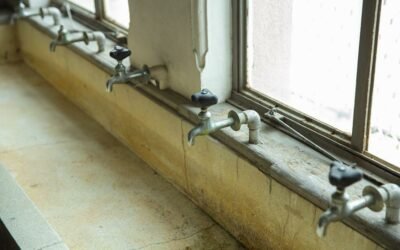If you've ever wondered if your microwave can kill mold, the answer is yes! In this article, we'll explore how microwaving can effectively eliminate mold and the factors you should consider before attempting this method.
You'll also find a step-by-step guide on how to safely microwave moldy items, along with alternative methods to eradicate mold. Just be sure to take the necessary precautions when using your microwave for mold removal.
Key Takeaways
- Microwaving uses heat and electromagnetic radiation to destroy mold cells by disrupting their structure.
- Different types of mold may require different treatment methods, and certain materials may not be suitable for microwaving.
- Timing and power level are crucial for effectively killing mold in the microwave.
- Alternative methods to effectively kill mold include using bleach solution, vinegar, hydrogen peroxide, tea tree oil, and baking soda.
How Does Microwaving Kill Mold
Microwaving kills mold by using heat to destroy the mold cells. When you place an item infested with mold into the microwave and set it to a high power level, the microwaves bombard the mold with electromagnetic radiation. This radiation is absorbed by the water molecules present in the mold cells, causing them to rapidly vibrate and generate heat. As the temperature rises, the heat disrupts the structure of the mold cells, leading to their destruction.
The key to effectively killing mold in the microwave lies in achieving the right combination of time and power level. The higher the power level and the longer the exposure time, the more heat is generated, resulting in greater destruction of mold cells. However, it's crucial to strike a balance to avoid damaging the item being treated or causing a fire hazard.
It is important to note that microwaving is most effective for killing mold on non-porous materials such as glass, ceramic, or plastic. Porous materials, like wood or fabric, may not heat up evenly in the microwave, allowing some mold cells to survive. Additionally, microwaving should never be used to treat food contaminated with mold, as it may not eliminate all the mold spores and toxins.
Factors to Consider Before Microwaving Moldy Items
Before microwaving moldy items, there are several factors you should consider. While microwaving can effectively kill mold, it's important to assess the situation and take necessary precautions. Here are some factors to keep in mind:
- Type of mold: Different types of mold may require different treatment methods. Some molds may release toxic spores when heated, so it's crucial to identify the type of mold before microwaving.
- Material of the item: Certain materials may not be suitable for microwaving, as they can be damaged or cause a fire hazard. Check the item's label or consult the manufacturer's guidelines to ensure it's microwave-safe.
- Size of the item: Large items may not heat evenly in the microwave, leaving some areas unaffected by the heat. It's important to consider the size of the item to ensure thorough mold eradication.
- Length of microwaving: Microwaving for too short a time may not effectively kill the mold, while overexposure can damage the item. Follow the recommended guidelines for microwaving time to achieve the desired results.
- Cleaning the microwave: After microwaving moldy items, it's crucial to clean the microwave thoroughly to prevent the spread of spores and eliminate any residual mold.
Step-By-Step Guide to Safely Microwave Moldy Items
To safely microwave moldy items, you'll need to follow a step-by-step guide. This guide will ensure that you eliminate the mold effectively and minimize any potential risks. Here is a precise and technical breakdown of the process:
- Preparation: Start by wearing protective gloves and a mask to prevent any exposure to mold spores. Place the moldy item on a microwave-safe plate or dish.
- Inspection: Carefully inspect the item for any signs of damage or deterioration. If the item is heavily damaged or crumbling, it may not be suitable for microwaving and should be disposed of instead.
- Cleaning: Use a damp cloth or sponge to remove any visible mold growth on the item. Make sure to clean all surfaces thoroughly.
- Microwave time: Set your microwave to the highest power setting and place the item inside. The duration will depend on the size and type of item, but generally, microwaving for 5 minutes should be sufficient.
- Ventilation: After microwaving, allow the item to cool down for a few minutes before opening the microwave door. This will prevent any mold spores from escaping into the air.
- Inspection and disposal: Carefully inspect the item again for any remaining mold. If there are still traces of mold, repeat the microwaving process. If the item is clean, dispose of any moldy materials properly.
Alternative Methods to Effectively Kill Mold
One effective method for killing mold is by using a bleach solution. Bleach contains chemicals that can effectively eliminate mold and prevent its growth. To effectively kill mold using bleach, follow these steps:
- Mix one cup of bleach with one gallon of water in a bucket.
- Use a scrub brush or sponge to apply the bleach solution to the mold-infested area.
- Scrub the area thoroughly to remove all visible mold.
- Let the bleach solution sit on the surface for at least 15 minutes to ensure that all mold spores are killed.
- Rinse the area with clean water and dry it completely.
It is important to note that bleach shouldn't be used on porous surfaces, as it can damage them. In such cases, alternative methods can be used, such as:
- Vinegar: Vinegar is a natural mold killer and can be used on porous surfaces.
- Hydrogen peroxide: Hydrogen peroxide is another effective mold killer that can be used on various surfaces.
- Tea tree oil: Tea tree oil has antifungal properties and can be used to kill and prevent mold.
- Baking soda: Baking soda can be used to remove mold and prevent its growth.
- Ammonia: Ammonia can be used to kill mold on non-porous surfaces. However, it should be used with caution and in well-ventilated areas.
Precautions to Take When Using Your Microwave for Mold Removal
To ensure safe and effective mold removal, it is important to take precautions when using your microwave. Microwaving moldy items can be an effective method to kill mold spores, but it is crucial to follow proper safety measures to avoid any accidents or health risks. Here are some precautions to keep in mind:
| Precaution | Explanation |
|---|---|
| Wear protective gear | Always wear gloves and a mask to protect yourself from mold spores and potential allergens that may be released during the process. |
| Use microwave-safe containers | Ensure that the container you use is microwave-safe and can withstand high temperatures. Glass or ceramic containers are generally safe options. Avoid using plastic containers, as they may melt or release harmful chemicals when heated. |
| Ventilate the area | Make sure the area where you are microwaving the moldy item is well-ventilated. Open windows or use a fan to improve air circulation and prevent the accumulation of mold spores in the room. |
| Monitor the microwave | Never leave the microwave unattended while microwaving moldy items. Keep a close eye on the process to prevent any potential fires or other hazards. |
Conclusion
In conclusion, microwaving is an effective method for killing mold. The heat generated by the microwave kills the mold spores, preventing further growth and contamination.
However, it's important to consider factors such as the material of the item, the extent of mold growth, and safety precautions before microwaving moldy items.
It's also worth noting that there are alternative methods available for mold removal.
Overall, microwaving can be a convenient and efficient solution for eliminating mold.






0 Comments